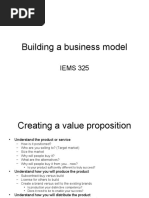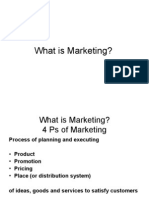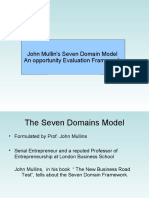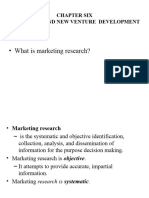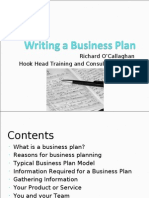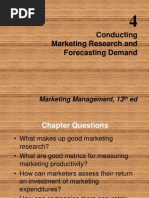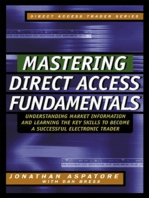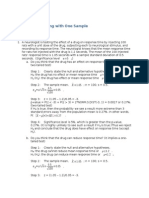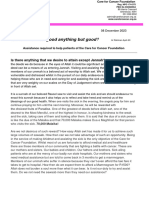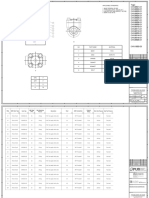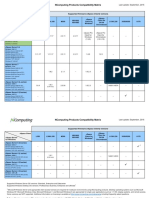Study Guide For Lecture 6 - Target Marketing II
Study Guide For Lecture 6 - Target Marketing II
Uploaded by
Wess SklasCopyright:
Available Formats
Study Guide For Lecture 6 - Target Marketing II
Study Guide For Lecture 6 - Target Marketing II
Uploaded by
Wess SklasOriginal Title
Copyright
Available Formats
Share this document
Did you find this document useful?
Is this content inappropriate?
Copyright:
Available Formats
Study Guide For Lecture 6 - Target Marketing II
Study Guide For Lecture 6 - Target Marketing II
Uploaded by
Wess SklasCopyright:
Available Formats
Study Guide for Lecture 6 Target Marketing 2 Positioning
Definition Developing a specific marketing mix to influence potential customers overall perception of a brand, product line, or organization in general. According to Ries and Trout Consumers organize products into categories in their mind. The goal of positioning is to be the first thing that comes to mind in the category. Two approaches Head to head positioning Direct competition Same attributes Differentiation positioning Different attributes than the market leader According to Bruce It is better to be first place in a small category than second place in a larger category America loves a winner Who was the second person to set foot on the moon Who was the first woman in space Seven up is the largest selling caffeine-free clear soft drink Ridiculous sports statistics How to you become the category leader? The easy way
Be there first First name in computers? First name in copiers?
The hard way Use the marketing mix to create a marketing position Expensive Remember about commercial information Hard to do
Three step process Figure out who you are Figure out where you want to be Design a plan to get from here to there
Figure out who you are According to Bruce: Many companies dont know how their customers actually perceive them Three usual sources of information Sales Feedback from people who make a living from you Self knowledge
Three good sources of information Complaints Critics Market research Internal marketing audit SWOT analysis The goal is to develop an honest and balanced understanding of who you are to your customers Identify the important attributes for a product class
Statistical tools Conjoint analysis What is important to the customer Multidimensional scaling Who is doing what Judgment
Perceptual map Graphic representation position Plot products graphically Identify gaps
Three Circles Positioning Framework
Design a plan to get there
What will it take to succeed in the new position Changes to the product Features Organizational resources To support the change To defend the position once the change is successful Anticipate competitive response Two basic approaches Create a new category
In the consumers mind The key is that you must be first in this category Swiffer product Leggs distribution
Repositioning Against the competition Create a new category relative to something familiar The Uncola Against yourself Miller Lite Prell
Forecasting
What is a forecast? Estimated sales of a product for a defined future period Bruce: A guess The effort you put into the guess depends on: How much is at stake The amount of uncertainty How the forecast will be used Terminology Market size Dollars Units You need both to understand market dynamics Market potential (Industry potential) Upper limit for the market If everybody who needed one bought one Sales potential Upper limit for you If everything went right, who much could you sell? Market share
The portion of a market captured by a single entity Usually expressed as a percent Market factor Exists in a market Is measurable Related to demand
Sales Forecast An actionable sales estimate based on: Sales potential Marketing plan Known mitigating factors Unknown mitigating factors Tennessee windage Over optimism
Methods
Market factor analysis
Correlation between demand and known market factors Advantages Relatively easy Reliable Disadvantages Requires known market factor Less useful for fashion and other volatile products
Works well in industrial markets OEM
If you are making tires, each new car starts out with 4 tires and a spare New car production schedules are market factors Aftermarket Sparkplug example
Survey knowledgeable people
Buyers intentions Ask your customers what they plan on purchasing in the next period Formal methods Survey Informal methods Canvassing i.e, working the crowd at conventions Works best in business markets Relatively few buyers Buyers know what they need
Advantage The customer is forecasting demand Disadvantage Can be used as a negotiating tactic Overestimate demand in order to get concession Assumes loyal customers
Salesforce survey Similar to buyer intentions Ask salespeople to estimate customer purchases Advantages Easier to get cooperation Front-line information
Disadvantages Fear of quotas Salespeople are optimistic by nature
Statistical methods
Trend analysis Future sales are projected based on previous results Time series analysis Cyclical adjustments Widely used in industries with relatively stable demand Best for short-term predictions
Advantage Very easy to use Disadvantages Straight line projection fallacy Ignores foreseeable environmental factors Henry Sibley High School
Test marketing Introduce product on a limited scale May be a full-blown introduction Complete marketing mix test May be used to test components of the marketing mix Product Promotion Most useful for new or unpredictable products Advantages Reliable information if done right Ability to fix things before going into large scale production Disadvantages
Expensive Time-consuming Give competitors a chance to copy you and be first to market
Judgment Direct forecast Senior executives estimate demand Best used in early stages of strategic projects Lost horse method Start with what you know about a historical fact Make assumptions about what has happened since
Advantage Timely Inexpensive You have some very smart people Disadvantage You are asking for opinions Biases
Chain ratio method
According to Bruce Combines the best of the other techniques Integrates forecasting into strategic management Conceptually Start with market potential Reduce the potential with a series of facts/assumptions that are critical to the strategic plan You end up with an actionable estimate that takes into account everything you know about the market Example Selling coffee in class Market potential 1400 (market factor)
x 10% attendance 140 (trend analysis) x coffee drinkers 70 (research) x havent already bought 18 (Judgment) x $1.00/cup - $18 Baseline forecast - $18 Now we play the what if games
How to use a sales forecast Recognize it is a guess Develop multiple scenarios Best case Worst case If you cant live with the worst case scenario, dont do it. Most likely Develop contingency plans What do you do if it works How to maximize profit What do you do if it doesnt Diagnose problems Minimize losses
You might also like
- Sample Questionnaire On Customer Satisfaction in BanksDocument6 pagesSample Questionnaire On Customer Satisfaction in Banks01.nazia591178% (40)
- Body Control System: SectionDocument44 pagesBody Control System: SectionYB MOTOR Nissan - Datsun Specialist100% (1)
- 3. Approaches in the analysis of marketing (1)Document72 pages3. Approaches in the analysis of marketing (1)embakomendiriasuma46No ratings yet
- Marketing: Session 1 Marketing Concept/Mix Marketing Planning & ControlDocument23 pagesMarketing: Session 1 Marketing Concept/Mix Marketing Planning & ControlmarinusvdbNo ratings yet
- Consumer BehaviourDocument29 pagesConsumer BehaviourvipinNo ratings yet
- Personal Selling: Preparation and Process: LBSIM, New DelhiDocument54 pagesPersonal Selling: Preparation and Process: LBSIM, New Delhishriya2413No ratings yet
- Lecture 7 - Marketing ResearchDocument30 pagesLecture 7 - Marketing ResearchababsenNo ratings yet
- Lecture 8-Customer DiscoveryDocument23 pagesLecture 8-Customer DiscoveryBrian Tan Xian HaoNo ratings yet
- Mercadeo Turistico - LGC.1. Marketing ABCDocument106 pagesMercadeo Turistico - LGC.1. Marketing ABCКатерина ІващенкоNo ratings yet
- Building A Business ModelDocument10 pagesBuilding A Business ModelInNUvationNo ratings yet
- Chapter 5 BitaraCabadduDalisay PresentationDocument26 pagesChapter 5 BitaraCabadduDalisay PresentationjgbitaraNo ratings yet
- Marketing For Entrepreneurs: by Amit Grover Nurture Talent AcademyDocument23 pagesMarketing For Entrepreneurs: by Amit Grover Nurture Talent AcademykingshukbNo ratings yet
- Conducting Marketing Research and Forecasting DemandDocument39 pagesConducting Marketing Research and Forecasting DemandShinjiNo ratings yet
- Week 1Document26 pagesWeek 1anver malikNo ratings yet
- Session 4 - 1preparing A Business PlanDocument72 pagesSession 4 - 1preparing A Business Plancoolpeer91No ratings yet
- 5 Marketing Research Its ComponentsDocument32 pages5 Marketing Research Its ComponentsDurga Prasad SmartNo ratings yet
- Business Plan-2Document33 pagesBusiness Plan-2Srinivas ShirurNo ratings yet
- MM Session 10Document53 pagesMM Session 10throwaway93262No ratings yet
- Ch08 Product Strategy and New Product DevelopmnetDocument22 pagesCh08 Product Strategy and New Product Developmnetkkyran727No ratings yet
- Business PlanningDocument171 pagesBusiness Planningjitendrasutar1975No ratings yet
- Chapter4 Feasibility of Idea ContinueDocument27 pagesChapter4 Feasibility of Idea ContinueCao ChanNo ratings yet
- Lecture 3 Market ResearchDocument26 pagesLecture 3 Market ResearchChristopher Padilla OrioNo ratings yet
- Marketing PlanDocument25 pagesMarketing PlanwasimalamNo ratings yet
- The 7ps of MarketingDocument70 pagesThe 7ps of MarketingjeushgabyuNo ratings yet
- Priyansu Dubey - MT - MM Marketing Research Btech Sem 02Document28 pagesPriyansu Dubey - MT - MM Marketing Research Btech Sem 02S Amit RaoNo ratings yet
- Marketing PDFDocument25 pagesMarketing PDFAman guptaNo ratings yet
- Retail Market StrategyDocument32 pagesRetail Market StrategybrijmacNo ratings yet
- 4.4 Market ResearchDocument46 pages4.4 Market ResearchLUIS JEANPIER MARTINEZNo ratings yet
- DE Step 1 - Market SegmentationDocument15 pagesDE Step 1 - Market Segmentationmaheennadeem586No ratings yet
- 4.1 The Role of MarketingDocument37 pages4.1 The Role of MarketingTita RachmawatiNo ratings yet
- Consumer Behavior: Customer Is Profit, All Else Is Overload...Document32 pagesConsumer Behavior: Customer Is Profit, All Else Is Overload...Mr. Asif Hanif Qureshi100% (1)
- Selling Skills Module FinalDocument11 pagesSelling Skills Module Finalajay gehlot100% (3)
- Mar3023 Exam 1 Review-1Document31 pagesMar3023 Exam 1 Review-1Anish SubramanianNo ratings yet
- Marketing Brief For BrochureDocument5 pagesMarketing Brief For BrochureKainNo ratings yet
- The Nature of Marketing ResearchDocument30 pagesThe Nature of Marketing Researchjolliebra0% (1)
- The Seven Domains Model - JabDocument27 pagesThe Seven Domains Model - JabpruthirajpNo ratings yet
- Session 3 - The Selling ProcessDocument16 pagesSession 3 - The Selling ProcessboldyNo ratings yet
- B2B Industrial Marketing Intelligence (Unit 4)Document17 pagesB2B Industrial Marketing Intelligence (Unit 4)Shreya Kadam100% (1)
- Business Opportunities Analysis: - Lecturer: Tran Minh Thu PHD - Email: Thutm@Ftu - Edu.VnDocument25 pagesBusiness Opportunities Analysis: - Lecturer: Tran Minh Thu PHD - Email: Thutm@Ftu - Edu.VnTiến Dũng ChuNo ratings yet
- MBA1 Case Interview Prep SlidesDocument24 pagesMBA1 Case Interview Prep Slidesbeatriz.marcicoNo ratings yet
- TCD Iii - 1Document35 pagesTCD Iii - 1tonyzone2003No ratings yet
- CH - 1 IntroductionDocument14 pagesCH - 1 IntroductionBir Betal MatketingNo ratings yet
- Role of Personal SellingDocument48 pagesRole of Personal SellingRishabh YadavNo ratings yet
- Market Research OverviewDocument48 pagesMarket Research Overviewkush_112No ratings yet
- PSM CondensedDocument4 pagesPSM CondensedAbhishek SharmaNo ratings yet
- The Nature of Marketing ResearchDocument30 pagesThe Nature of Marketing ResearchGauri NairNo ratings yet
- Marketing Planning ConsolidatedDocument115 pagesMarketing Planning ConsolidatedAhmed El-BadawyNo ratings yet
- Mba Enter ch6Document50 pagesMba Enter ch6Hussen MohammedNo ratings yet
- 1 Writing A Business PlanDocument31 pages1 Writing A Business Planocallagr100% (6)
- Conducting Marketing Research and Forecasting DemandDocument41 pagesConducting Marketing Research and Forecasting Demanddrsamia27No ratings yet
- Mar3023 Exam 1 Review-1Document31 pagesMar3023 Exam 1 Review-1Anish SubramanianNo ratings yet
- 10,11 - Marketing Research Slides-1Document18 pages10,11 - Marketing Research Slides-1Ibrahim ManshaNo ratings yet
- Selling and Sales Management 10 Edition By: David Jobber & Geoff Lancaster Published by PearsonDocument14 pagesSelling and Sales Management 10 Edition By: David Jobber & Geoff Lancaster Published by PearsonaliiNo ratings yet
- CustomerDocument28 pagesCustomerJoseph FrancisNo ratings yet
- Marketing Strategy ToolsDocument63 pagesMarketing Strategy ToolsDrawde NalisacNo ratings yet
- Introduction To Market ResearchDocument12 pagesIntroduction To Market ResearchvarshachaurasiyaNo ratings yet
- Strategic Selling Review 19991011Document52 pagesStrategic Selling Review 19991011jturner5520100% (2)
- Chapter - 4 Demand Forecasting & Market Potential AnalysisDocument71 pagesChapter - 4 Demand Forecasting & Market Potential AnalysisBook wormNo ratings yet
- Create Demand for What You Sell: The 7 High-Impact StrategiesFrom EverandCreate Demand for What You Sell: The 7 High-Impact StrategiesNo ratings yet
- Normal Distribution Examples and ExercisesDocument3 pagesNormal Distribution Examples and ExercisesWess SklasNo ratings yet
- Hypothesis Testing Examples and ExercisesDocument3 pagesHypothesis Testing Examples and ExercisesWess SklasNo ratings yet
- Central Limit Theorem Examples and ExercisesDocument4 pagesCentral Limit Theorem Examples and ExercisesWess SklasNo ratings yet
- P (W/A) P (W&A) /P (A) 2.56%/8.77 29.19% 29.19 % Is The Probability That The Person Is A WomanDocument1 pageP (W/A) P (W&A) /P (A) 2.56%/8.77 29.19% 29.19 % Is The Probability That The Person Is A WomanWess SklasNo ratings yet
- EKL Catalogue of 2015 Part 1Document33 pagesEKL Catalogue of 2015 Part 1joyceNo ratings yet
- Statistics Data Science PDFDocument10 pagesStatistics Data Science PDFPeter PuyneersNo ratings yet
- Shida: - EvarDocument107 pagesShida: - Evarpravin mundeNo ratings yet
- Euromonitor Final Report - Hot Beverages in East Africa 2017 12 21 PDFDocument131 pagesEuromonitor Final Report - Hot Beverages in East Africa 2017 12 21 PDFprateekchaturvediNo ratings yet
- Ccs Rsa RulesDocument7 pagesCcs Rsa Rulesptkdiv.crNo ratings yet
- DDDDDDocument4 pagesDDDDDhabtamufenta386No ratings yet
- HeyhhuDocument10 pagesHeyhhuAbhijeet JhankalNo ratings yet
- ShashaDocument23 pagesShashashashalie01No ratings yet
- Heat Loss During Steam InjectionDocument8 pagesHeat Loss During Steam InjectionahmedNo ratings yet
- Reflection Paper (Philippine-American Cultural Interaction)Document2 pagesReflection Paper (Philippine-American Cultural Interaction)MASSO CALINTAANNo ratings yet
- Giáo Án Anh 8 Global Success Unit 7Document36 pagesGiáo Án Anh 8 Global Success Unit 7Phương Thảo LêNo ratings yet
- Grammar 9 (Inverted Subject and Verb)Document19 pagesGrammar 9 (Inverted Subject and Verb)M Dwi RafkyNo ratings yet
- Application Letter For A Software Developer PositionDocument2 pagesApplication Letter For A Software Developer PositionRichard TagoeNo ratings yet
- Document 34Document5 pagesDocument 34LaibaNo ratings yet
- 27) Again On Ent. 28 IV 30-33 // 29 V 17-20 ( RIME 1.9.5.1) - in His Edition of The Presargonic RoyalDocument4 pages27) Again On Ent. 28 IV 30-33 // 29 V 17-20 ( RIME 1.9.5.1) - in His Edition of The Presargonic RoyaleannatumNo ratings yet
- Donna Patrick PDFDocument250 pagesDonna Patrick PDFPetiscos PetiscosNo ratings yet
- Cellular Responses To Stress and Toxic Insults: Adaptation, Injury, and DeathDocument81 pagesCellular Responses To Stress and Toxic Insults: Adaptation, Injury, and DeathICE ADRIENNE OCAMPONo ratings yet
- STA304 Assignment 1Document5 pagesSTA304 Assignment 1rchen500No ratings yet
- Cancer Patient RequestDocument3 pagesCancer Patient RequestEbiemNo ratings yet
- Qurate Retail GroupDocument17 pagesQurate Retail GroupMo Faizan AfzalNo ratings yet
- High Basic Month 2 Curriculum - Exponential English 2Document19 pagesHigh Basic Month 2 Curriculum - Exponential English 2Xander ThrumbleNo ratings yet
- Kinematical Analysis On The Several Linkage Drives For Mechanical PressesDocument13 pagesKinematical Analysis On The Several Linkage Drives For Mechanical PressesKenny Everett Steve WilsonNo ratings yet
- Ais Connection ProcedureDocument4 pagesAis Connection ProcedureKuang Ah HockNo ratings yet
- Narcolepsy and CataplexyDocument6 pagesNarcolepsy and CataplexyAh BoonNo ratings yet
- Octopamine QuestionsDocument2 pagesOctopamine QuestionsAnonymous 7KQKySNo ratings yet
- Astro Support ResistanceDocument24 pagesAstro Support ResistanceVinod PatilNo ratings yet
- Piston Check ValveDocument2 pagesPiston Check ValvemaunghkNo ratings yet
- Reference VSpace-OS-Compatibility (En) 133091Document4 pagesReference VSpace-OS-Compatibility (En) 133091Ddt DdmNo ratings yet









